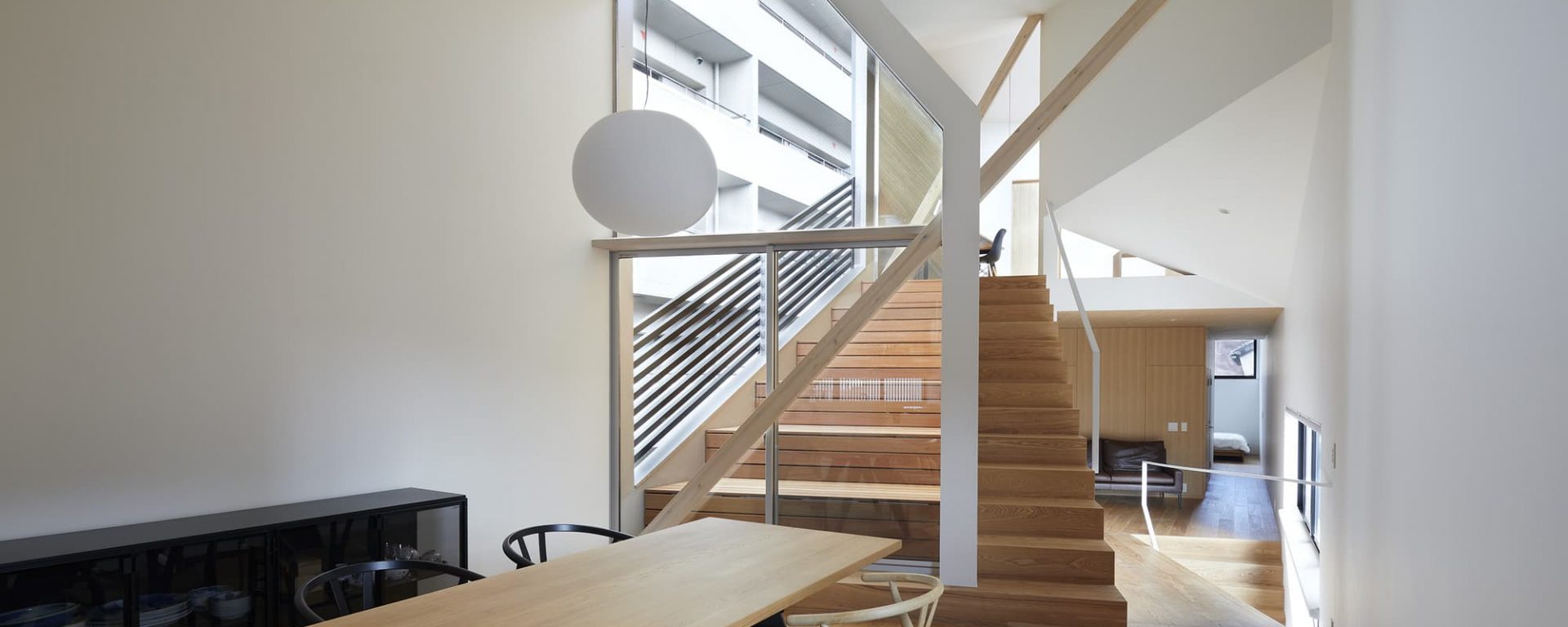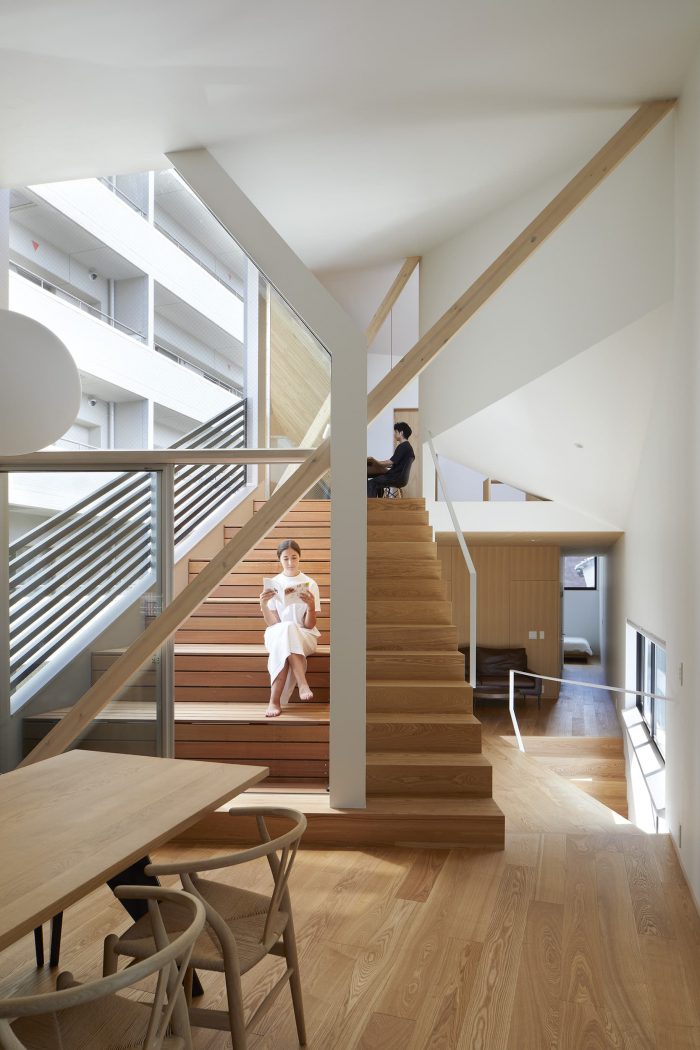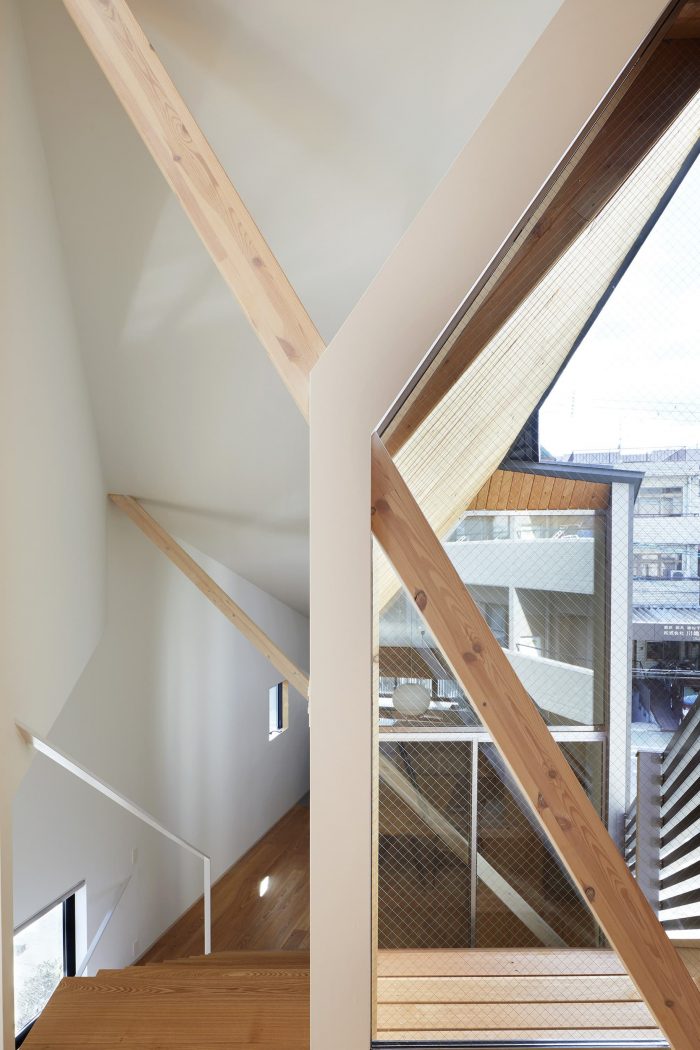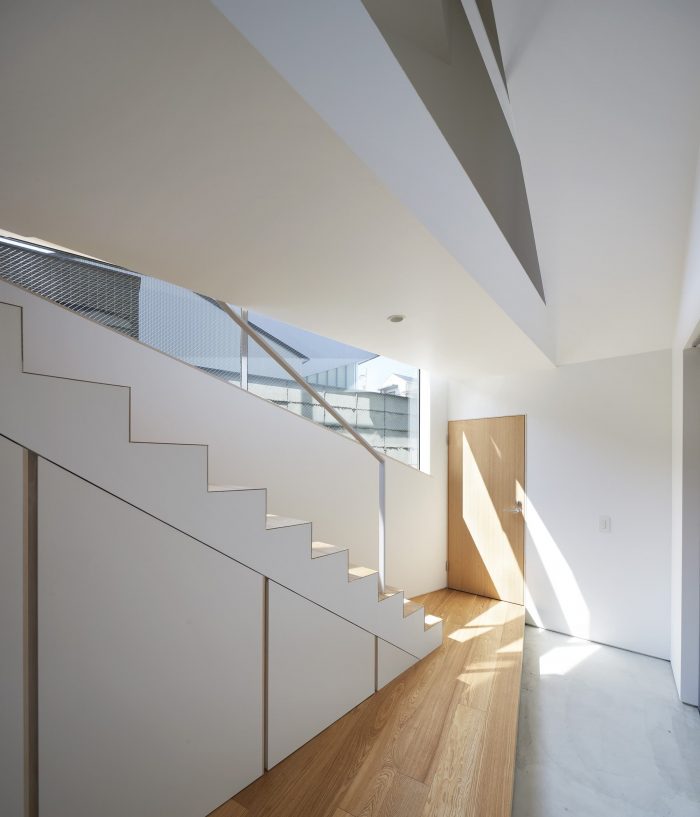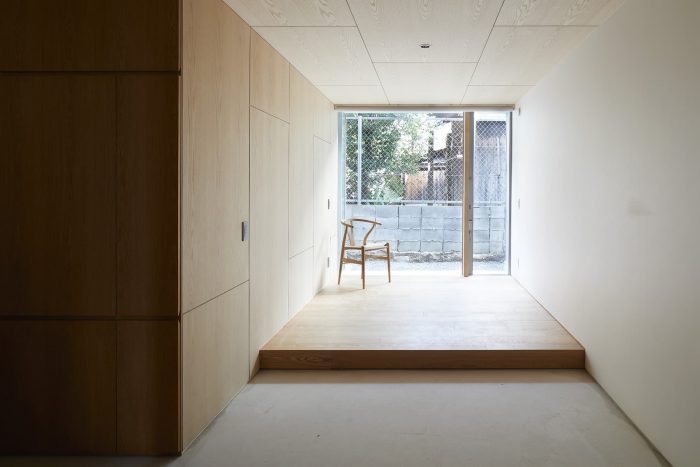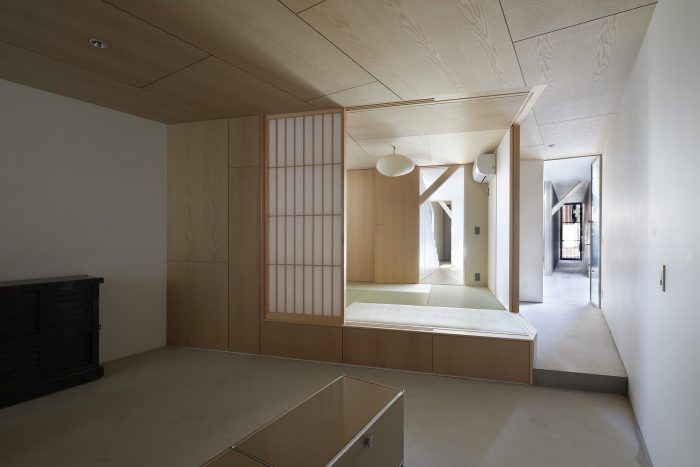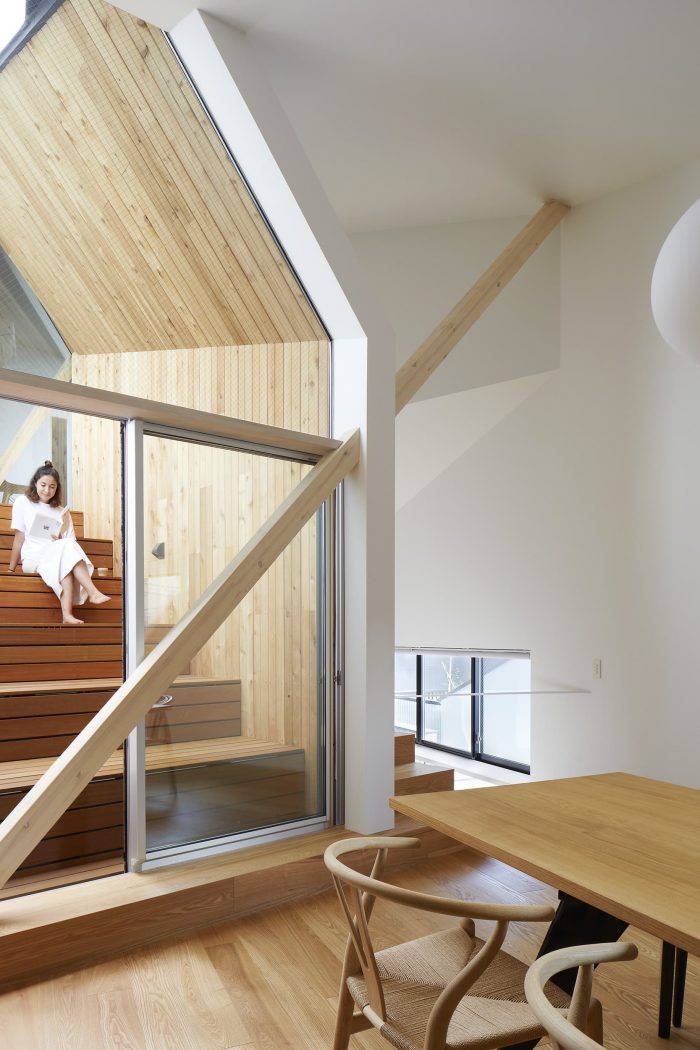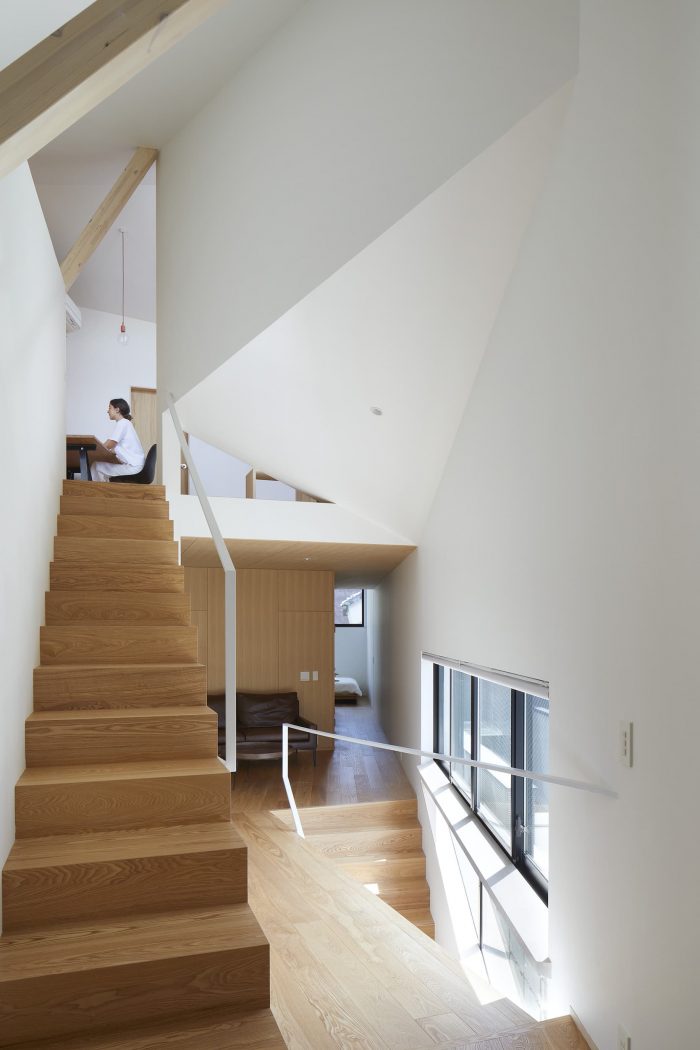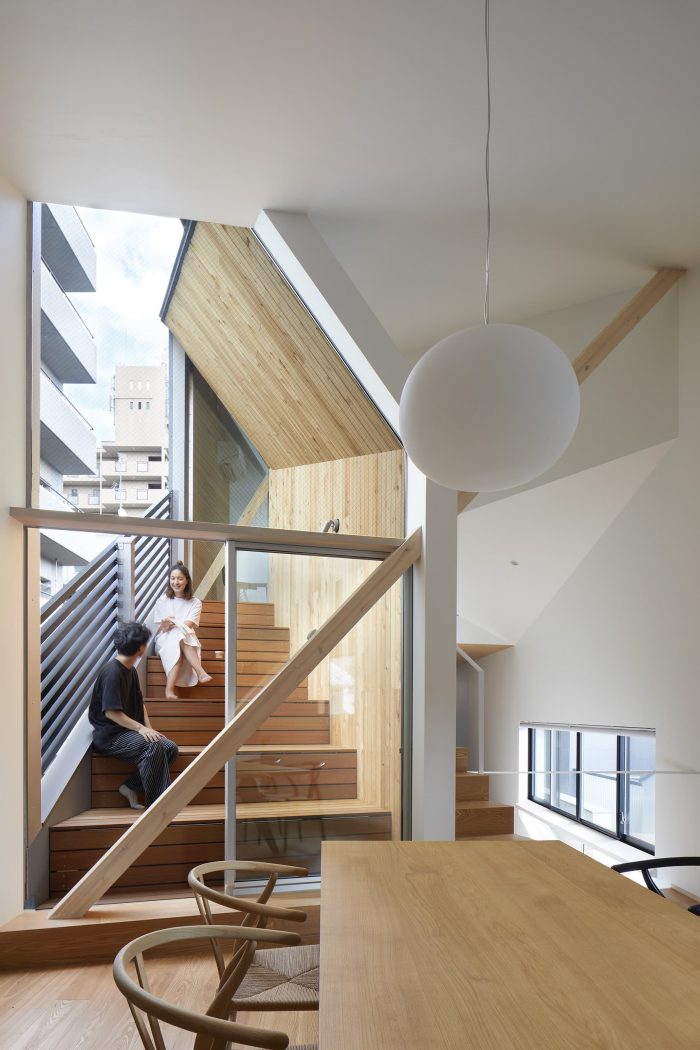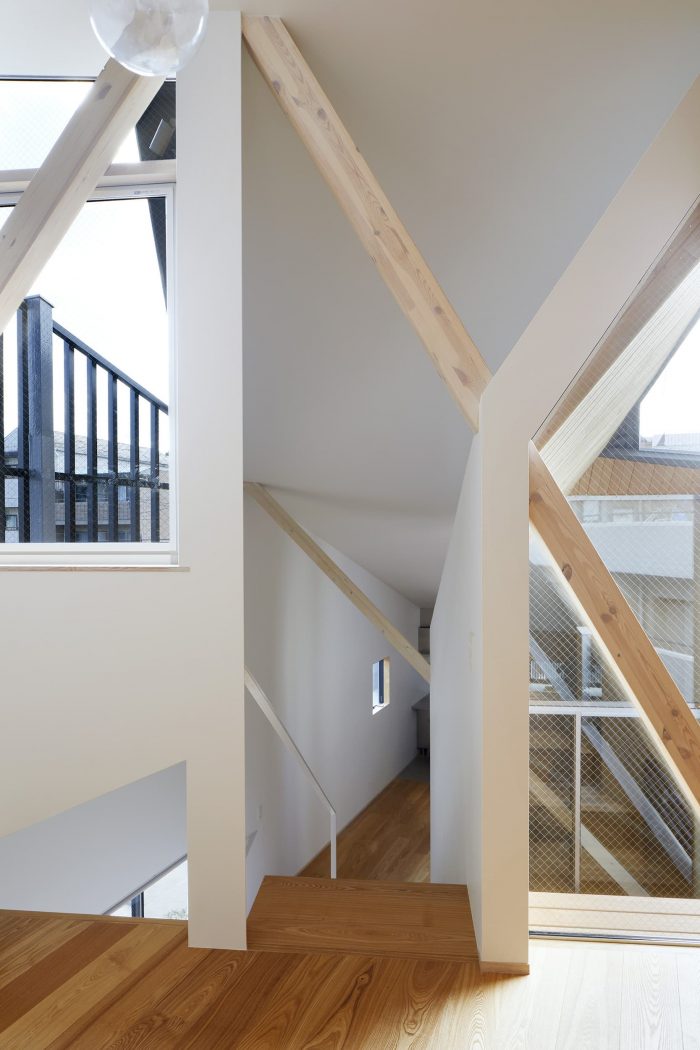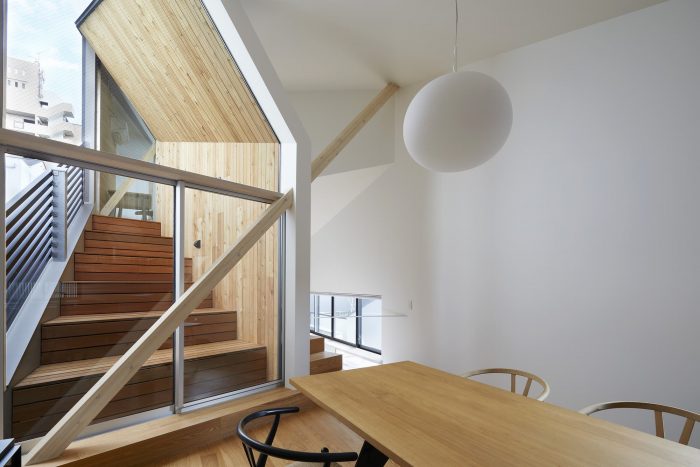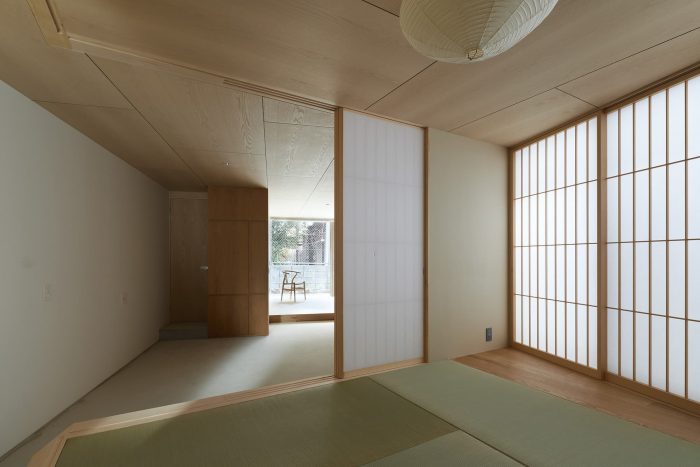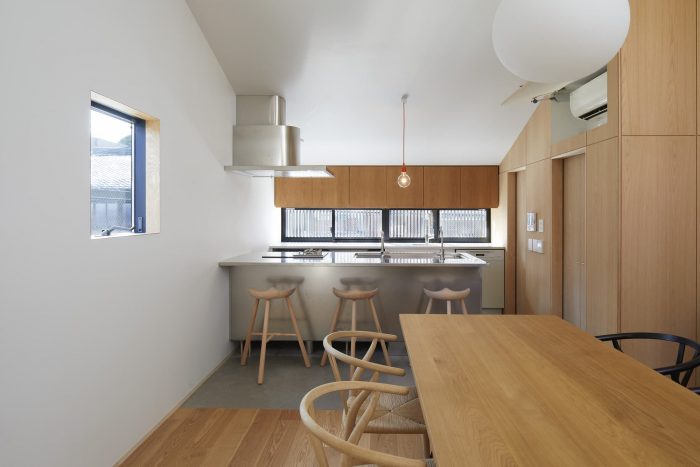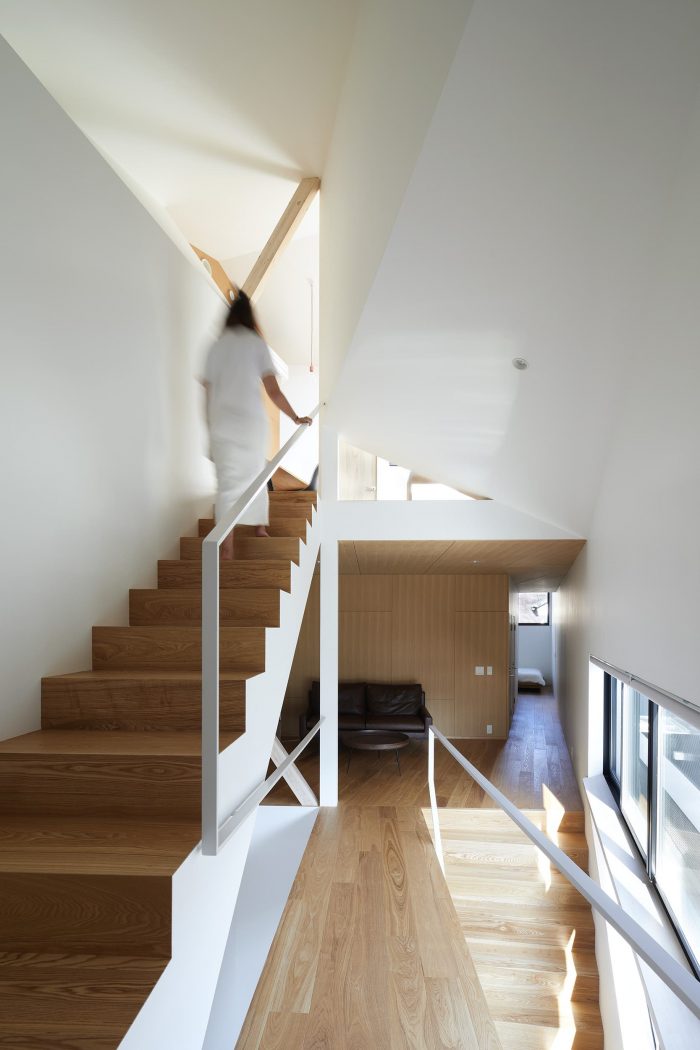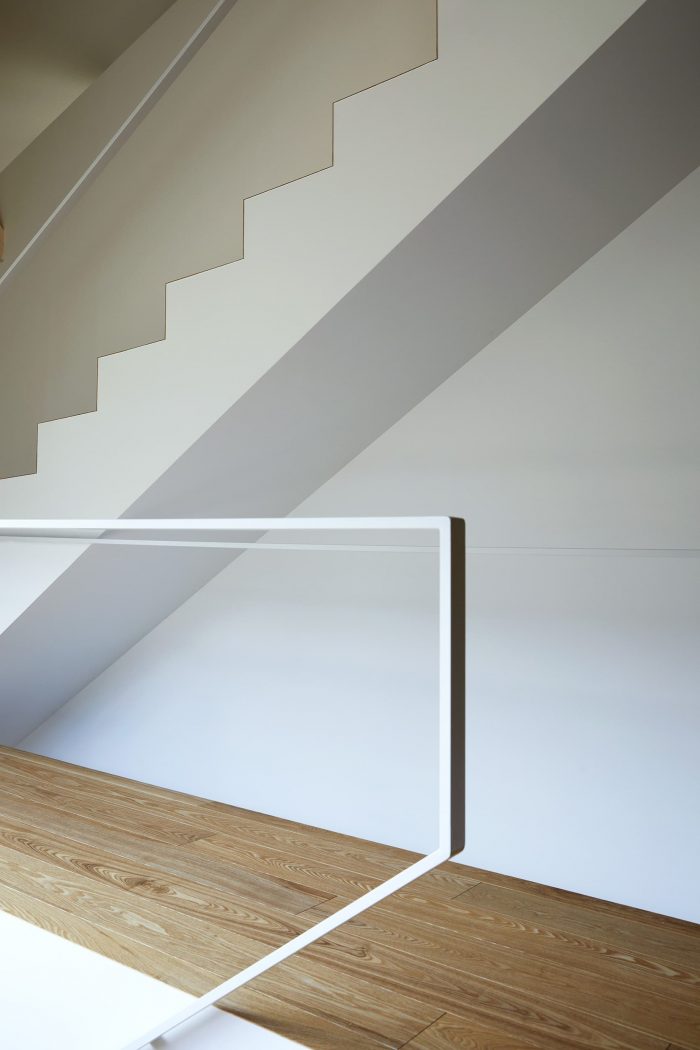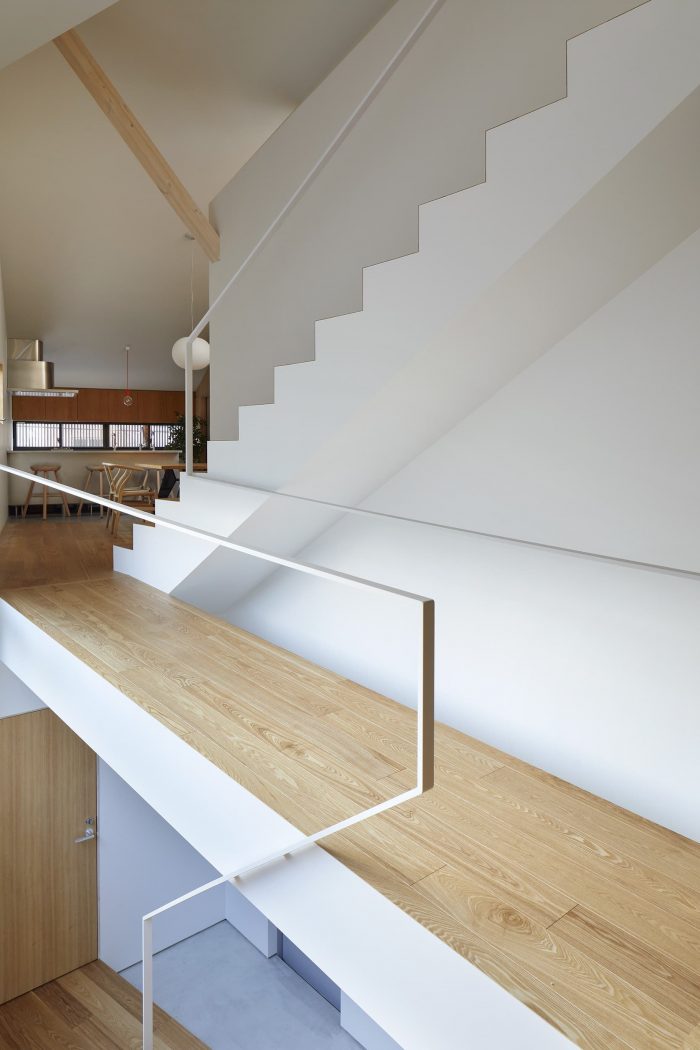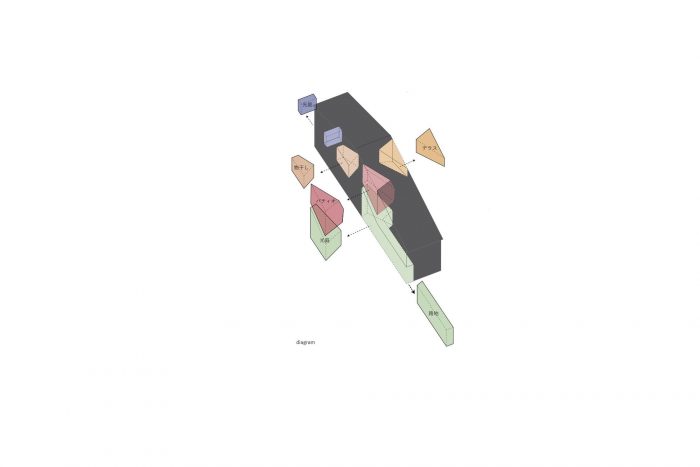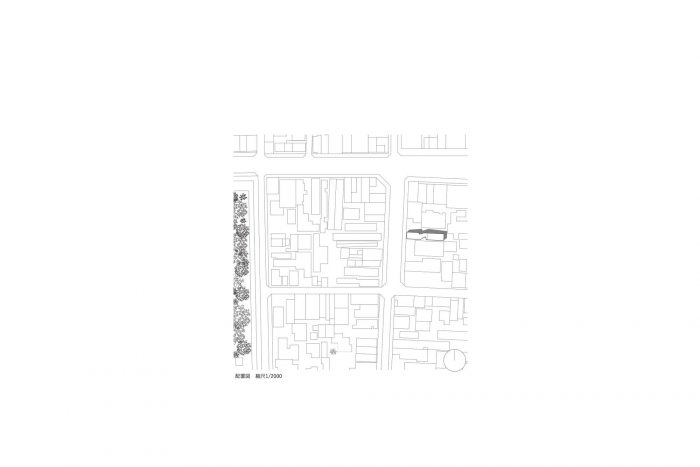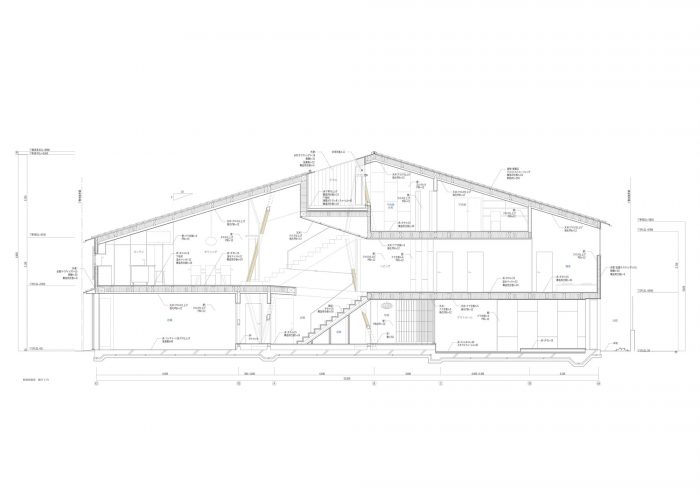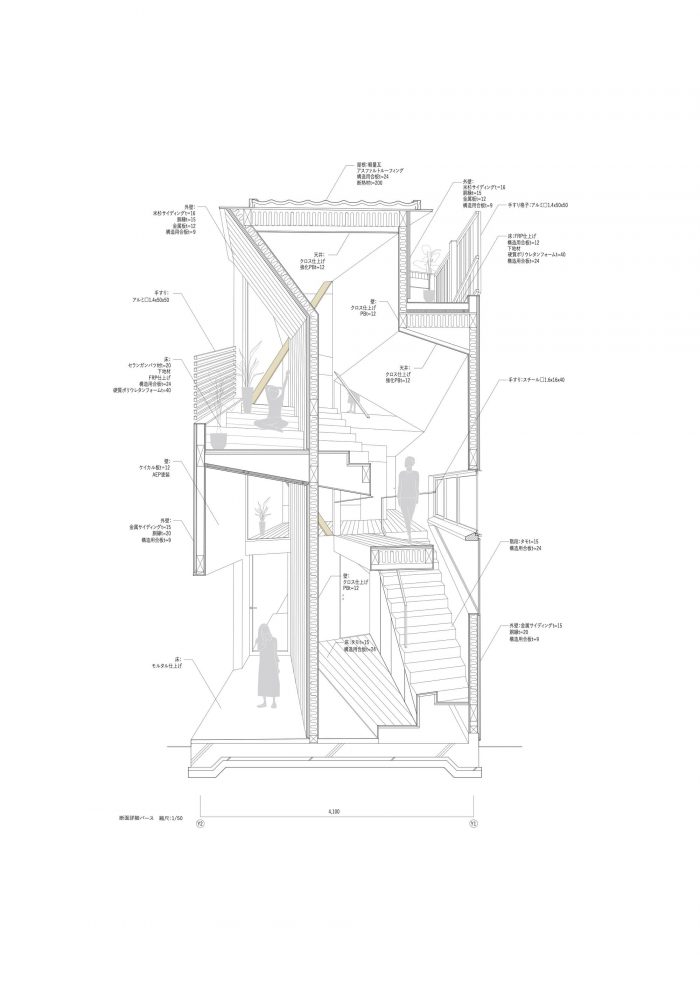叠加椿树花园–传统上,京都的平面密度很高,联排别墅在狭窄的土地上一字排开,横截面密度很低。由于低层建筑沿街排列,丰富的生活空间通过在平面上安排外部空间如街心花园和椿树来保证。然而今天,虽然平面密度保持不变,但在截面上对中高层建筑的需求越来越大,房屋必须想办法在新形势下纳入有效的外部空间,同时利用城市的特殊性。
Stacking Tsuboniwa Gardens – Traditionally, Kyoto has had a high planar density with townhouses in rows on a narrow strip of land and a low cross-sectional density. With low-rise buildings lining the street, that rich living space has been secured by arranging external spaces such as street gardens and tsuboniwa on a planar scale. Today, however, while the planar density remains the same, there is a growing demand for mid to high-rise buildings in cross-sectional terms, and houses must devise ways to incorporate effective exterior spaces in the new situation while taking advantage of the special characteristics of the city.
住户来自一个日本家庭,但在美国开展业务的同时,孩子们在日本上学,并在美国度过漫长的假期。因此,一个活跃的家庭所需要的外部空间,如天井、露台和轻型花园,都被立体地从房子里雕刻出来,并构想出围绕这些雕刻出来的区域发展的生活方式。作为雕刻的辅助线,引入了一条倾斜于城市网格的轴线,使其斜着延伸到场地内的寺町街,这是房屋所面临的繁华街道,允许从内部通过外部空间看到城市,并允许光线和风通过房屋区域。
The residents are from a Japanese family, but while conducting business in the USA, the children are attending school in Japan and spend long vacations in the USA. Therefore, the exterior spaces needed by an active family, such as a patio, terrace, and light garden, were three-dimensionally carved out of the house, and a lifestyle that developed around these carved-out areas was conceived. As an auxiliary line to the carving, an axis tilted to the urban grid was introduced, so that it extends diagonally across the site to Teramachi Street, the bustling street to which the house faces, allowing the view from the interior to the city through the exterior spaces, and allowing light and wind to pass through inside the house area.
这是一个立体排列的tsuboniwa花园。为了让人、视线和自然通过,在倾斜的轴线上,从一楼到三楼连续放置了单吊支架,而不是承重墙。每一个外部空间都像一个多边形的棱镜,给住在狭长的房子里的人一种向各个方向延伸的空间感,不管是深入还是向天空开放,还是向远处的城市眺望,都切割出京都的新表达。(竹口健太郎+山本麻子)。
It is a tsuboniwa garden arranged three-dimensionally. To allow people, the line of sight, and nature to pass through, single-hung braces, rather than load-bearing walls, were placed continuously from the first to the third floor on the inclined axis. Each of these exterior spaces works like a polygonal prism, giving the people living in the long and narrow house a sense of space that extends in all directions, whether deep or open to the sky, or looking out over the city in the distance, and cutting a new expression of Kyoto. (Kentaro Takeguchi + Asako Yamamoto)
与空间质量相呼应的支架–由中央中庭的楼梯和坡道连接的前后两层跳楼的配置与以往的新京都大厦项目相一致。这一次,我们重点加强了插入中央中庭的空隙空间(天井、露台和灯光花园),这是与正统联排别墅体量不同的逻辑。在街边和后边有许多房间和墙壁的区域,支撑物被放置在墙壁内(”支撑物=墙壁”)。而在中央中庭,为了保持空隙空间的独立性,决定让支架暴露在外面,通过采取大的姿态,使用单挂支架让人们穿行,使 “支架≠墙”。支架的使用是为了应对空间的质量而尝试的。(Jun Yanagimuro)
Braces that respond to the quality of the space – The configuration of the front and rear skip floors connected by stairs and ramps in the central atrium is in keeping with previous NEW KYOTO TOWN HOUSE projects. This time, we focused on enhancing the void spaces (patio, terrace, and light garden) inserted in the central atrium, which is a different logic from the orthodox townhouse volume. In the zones with many rooms and walls on the street side and the rear side, the braces are placed inside the walls (“braces = walls”). While in the central atrium, to maintain the independence of the void spaces, it was decided to leave the braces exposed, and by taking a large stance, single-hung braces were used to allow people to walk through, making “braces ≠ walls”. The use of braces was attempted in response to the quality of the space. (Jun Yanagimuro)
京都通过将从街道到房屋内部花园(Toriniwa和Tsuboniwa)的水平视野与城市景观和山脉相融合,确保了美丽的生活空间。但近年来,当高层建筑受到追捧时,需要设计出有效结合外部空间的方法,比如像布尔运算一样从房屋中立体地移除天井(立体Tsuboniwa),并通过立体庭院发展生活。通过引入三维庭院作为倾斜于城市网格的轴线,并从一楼到三楼使用单面延续的支架而不是承重墙,长边的空隙可以将自然与房屋连接起来。这些外部空间给居住在狭长房屋中的居民带来了空间感,作为京都的一种新的表达方式向城市扩散。
Kyoto has secured a beautiful living space by blending horizontal views from the street to the house’s inner garden (Toriniwa and Tsuboniwa) with the cityscape and mountains. But in recent years, when high-rise buildings are in demand, there is a need to devise ways to effectively incorporate external spaces, such as removing patios (3d Tsuboniwa) three-dimensionally from the house like Boolean operations and developing life through the three-dimensional courtyard. By introducing a three-dimensional courtyard as an axis tilted against the city grid and using a one-sided continuation of braces instead of bearing walls from the first floor to the third floor, the void on the long side can connect nature to the house. These external spaces give the residents who live in long and narrow houses a sense of space that spreads out into the city as a new expression of Kyoto.
Architects: Alphaville Architects
Area : 218 m²
Year : 2022
Lead Architects : Kentaro Takeguchi, Asako Yamamoto
Structural Design : Jun Yanagimuro Structural Design
City : Kyoto
Country : Japan

